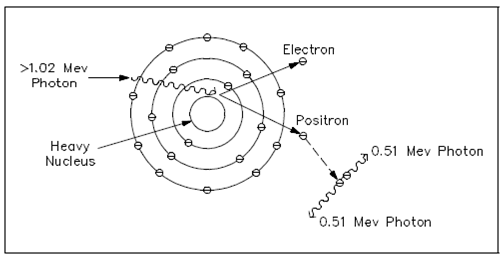Pair Production:
At higher energy levels, pair production is predominate. While a high energy gamma passes close sufficient to a heavy nucleus, the gamma disappears and their energy reappears in the form of an electron and a positron (similar mass as an electron, but has a positive charge), as display in next Figure. This transformation of energy into mass must take place near a particle, such as a nucleus, to conserve momentum. A kinetic energy of the recoiling nucleus is extremely small; thus, all of the photon's energy which is in excess of which required to supply the mass of the pair appears as kinetic energy of the pair. By this reaction to take place, the actual gamma must have at least 1.02 MeV energy.

Figure: Pair Production
The electron loses energy through ionization. The positron interacts along with other electrons and loses energy through ionizing them. It will combine with an electron (mutual annihilation occurs), and the energy is released as a gamma if the energy of the positron is low sufficient. The possibility of pair production raises significantly for higher energy gammas.
Gamma radiation has an extremely high penetrating power. A small fraction of the actual stream will pass by various feet of concrete or several meters of air. The specific ionization of a gamma is low compared to which of an alpha particle, but is higher than which of a beta particle.